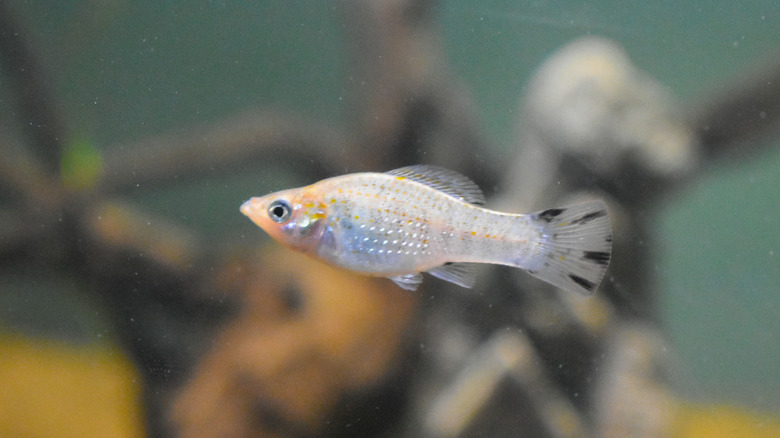Molly Sexing: How To Tell The Difference Between Male & Female Molly Fish
Molly fish are easy-to-keep aquarium fish who reproduce easily in the tank and come in a wide range of colors and shapes. The sexes are easy to tell apart, so if you have at least one male and one female in your tank, you can witness the fascinating cycle of mating and live birth.
Molly fish male and female
Molly fish male and female
Juvenile mollies of each type all look pretty much identical, with big eyes and a spindly, wriggling tail. Gold dust molly male and female fry are all gold and black, for example, with no notable markings to tell the genders apart. Mollies reproduce almost constantly throughout their one- to five-year life span. As they are mature in about eight weeks, it's likely the female mollies you buy from the store are already pregnant.
Male molly fish tend to be smaller than females. They are easily recognizable by their long, specialized anal fin that is used to deposit eggs in females. Males of fancy species, such as sailfin mollies or lyretail mollies, have longer, more elaborate fins that give each variation its name.
Female mollies are bigger and wider in the belly than male mollies. As live bearers, they retain and hatch their fertilized eggs inside their body, eventually giving birth to an average of 80 fry at a time. A healthy fish with a big, lumpy belly is a female. Sometimes, you can even see the eyes of the fry inside the female through the stretched skin of a light-colored belly.
More gender differences
More gender differences
Like most fish, male and female mollies have differently shaped fins. Female fins are rounder and shorter. Their tails have rounded edges as well. In some types, male fins are pointy on the ends, and their tail has more angled edges. Fancy molly fish types have long, flowing fins on males, and females have shorter fancy fins that are held close to their bodies but not clamped.
You can also tell the molly fish male and female by comparing their coloring. The males tend to be more richly colored, such as the charcoal black of the black lyretail molly or the vibrant orange tones of the gold dust molly. Females are more demurely colored. Black female mollies can have a brown or gold undertone, while orange-type mollies are more of a pastel shade.
No doubt about gender
No doubt about gender
Your mollies won't leave you wondering for long whether they are male or female. Mollies can give birth nearly every month when the water temperature is on the warmer end of their 75- to 80-degree ideal range. If your water is at the cool end of this spectrum, your mollies are less likely to give off behavioral clues to their gender that occur during breeding.
Some fishkeepers cool aquariums to the lowest temperature in which fish aren't stressed to prevent unwanted fry. This is the only way to effectively slow down molly breeding, as female fish can retain sperm in their body to become pregnant even when there is no male around. Female molly fish are almost always in some state of pregnancy, emphasizing their wider build that differentiates them from males.
Raising molly fry
Raising molly fry
Since mollies are peaceful, several types can coexist in the same tank and might even interbreed. Mollies eat everything they can fit in their mouth, however. That includes their own young. Provide plenty of hiding places in your aquarium for fry to hide, such as floating plants, dense foliage, and small caves and crevices inaccessible to fully grown fish. A breeding cage that allows fry to drop through to an area their mother can't access is another option.
